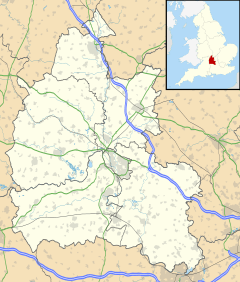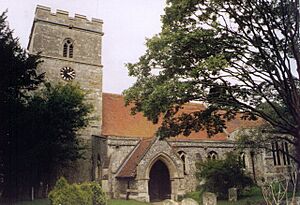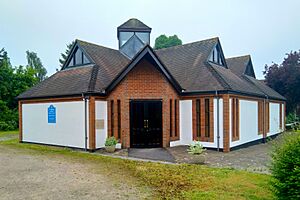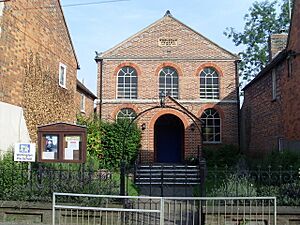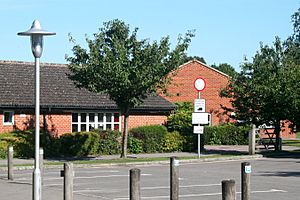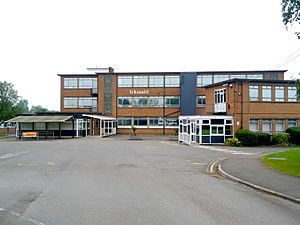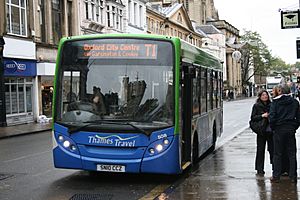Watlington, Oxfordshire facts for kids
Quick facts for kids Watlington |
|
|---|---|
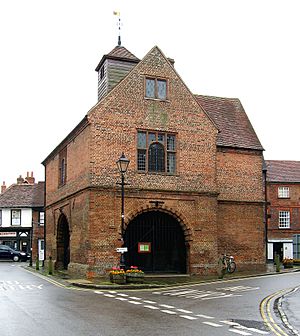 Watlington Town Hall |
|
| Area | 14.55 km2 (5.62 sq mi) |
| Population | 2,727 (parish, 2011 Census) |
| • Density | 187/km2 (480/sq mi) |
| OS grid reference | SU687945 |
| • London | 43 mi (69 km) |
| Civil parish |
|
| District | |
| Shire county | |
| Region | |
| Country | England |
| Sovereign state | United Kingdom |
| Post town | Watlington |
| Postcode district | OX49 |
| Dialling code | 01491 |
| Police | Thames Valley |
| Fire | Oxfordshire |
| Ambulance | South Central |
| EU Parliament | South East England |
| UK Parliament |
|
| Website | Watlington Parish Council |
Watlington is a small market town and civil parish in Oxfordshire, England. It's about 7 miles (11 km) south of Thame. The town is close to the border with Buckinghamshire.
The parish of Watlington includes small villages called hamlets. These are Christmas Common, Greenfield, and Howe Hill. All of these are located in the beautiful Chiltern Hills. In 2011, about 2,727 people lived in Watlington.
Contents
History of Watlington
People likely settled in the Watlington area a very long time ago. This was probably because of the nearby Icknield Way, an ancient trackway. The name "Watlington" means "settlement of Waecel's people." This suggests people lived here from around the 6th century.
In the 9th century, a document from Æthelred of Mercia mentioned eight large homes, or 'manses', in Watlington. The Domesday Book of 1086, which was a big survey of England, called the town Watelintone or Watelintune. Old papers from the 14th century show that the town's streets, like Couching Street and Brook Street, were already laid out as they are today.
Watlington has had inns (like hotels or pubs) since the 15th century. In 1722, the town's market was held every Saturday. By the late 1700s, there were six inns. A local brewing family, the Haywards, bought them all. Later, in the 19th century, a Methodist named George Wilkinson bought six inns and closed them. Today, Watlington has three public houses: The Spire & Spoke, The Chequers, and The Fat Fox Inn.
During the English Civil War, soldiers who supported Parliament stayed in Watlington. It's believed that John Hampden, a famous Parliamentarian, stayed in the town the night before the Battle of Chalgrove Field.
Watlington Town Hall and Schools
In 1664–65, the Watlington Town Hall was built. Thomas Stonor paid for it. The top room of the Town Hall was used as a grammar school for boys. In 1731, Dame Alice Tipping gave more money to help more students attend.
In 1842, the town's local council, called the Vestry, started a National School. This school also used rooms in the Town Hall. A year later, in 1843, a National School for girls was built next to St Leonard's church.
In 1872, both the boys' and girls' schools joined to form a new Board school. This school was connected to the National Society for Promoting Religious Education. In 1927, the school split into a junior school and a senior school. A new secondary school, the Icknield School, opened in 1956 for older students. The primary school then took over the old buildings. Today, the Icknield School is known as Icknield Community College.
By 1895, the Town Hall was not used as a school anymore and needed repairs. In 1907, people donated money to restore it. The Town Hall is a well-known building where three roads meet in the town center.
Since 1990, Watlington has been twinned with Mansle, a town in France.
The Watlington Hoard
In 2015, an amateur metal detectorist named James Mather found a collection of silver items in Watlington. This collection, known as the Watlington Hoard, dates back to the 9th century, during the time of Alfred the Great. The hoard was carefully dug up and later bought by the Ashmolean Museum in Oxford for a large sum of money.
Watlington Hill and the White Mark
Watlington town sits at the bottom of Watlington Hill. This hill is 240 meters (787 feet) high and is on the western edge of the Chiltern Hills Area of Outstanding Natural Beauty. The The Ridgeway National Trail walking path, which is part of the longer Icknield Way, goes near the town and the hill.
Because it's so close to the Chilterns, Watlington is a great place for outdoor activities. You can enjoy hill walking, cycling, and birdwatching here. Many red kite birds, which are beautiful birds of prey, live in the area.
Watlington Hill is home to many different plants (flora) and animals (fauna). It is a Site of Special Scientific Interest (SSSI) as part of Watlington and Pyrton Hills. The National Trust looks after it. Nearby, Shirburn Hill is also an SSSI.
The Watlington White Mark is a unique shape cut into the chalk soil of Watlington Hill. A local landowner, Edward Horne, designed it in 1764. He thought that the parish church of St Leonard would look better from his home if it had a spire (a tall, pointed roof). So, he had this unusual folly (a building or structure built just for decoration) cut into the chalk. Local residents still maintain the mark today. It is 36 feet (11 meters) wide at its base and 270 feet (82 meters) long.
Churches in Watlington
Church of England
The oldest parts of the Church of England parish church of St Leonard are from the Norman period. This includes a decorated stone panel called a diapered tympanum. This was above the north door until it was removed when the north aisle was built.
The church was largely rebuilt in the 14th century. The arcade (a row of arches) of the south aisle is from this time. The south chapel was built in the 15th century for Maud Warner to remember her husband, Richard, a wool merchant. The church tower is also from the Medieval period. Some windows from the Decorated Gothic and Perpendicular Gothic styles still exist. In the 1870s, some windows were moved to different places within the church.
In 1763, Edward Horne, a local landowner, got permission to build a burial vault (an underground burial chamber) east of the Warner chapel. In 1877, architects H.J. Tollit and Edwin Dolby restored St Leonard's. The church is a Grade II* listed building, which means it's a very important historic building.
The west tower of the church had six bells until 1909. Then, two new bells were added, making a total of eight. Different bell makers cast these bells over many years, from 1587 to 1905. St Leonard's parish is now part of the Icknield Benefice. This group also includes the parishes of Britwell Salome, Pyrton, and Swyncombe.
Roman Catholic Church
During the English Reformation in the 16th century, many people in Oxfordshire remained Roman Catholic even though the official religion changed. In 1549, William Grey was sent to Oxfordshire with soldiers to make sure people followed the new religious rules. A Catholic man from Watlington, William Boolar, was executed as an example.
Despite these difficulties, some local landowning families, like the Stonors, remained Catholic. They and their priests supported other Catholics in the area. In 1930, Father William Brown helped build the Roman Catholic church of the Sacred Heart in Watlington. The current Roman Catholic church in Watlington is named after St Edmund Campion. He was a Jesuit priest who was executed in 1581.
Non-conformist Churches
In the 17th and 18th centuries, several nonconformist groups existed in Watlington. These included Quakers, Baptists, and Seventh Day Baptists at different times.
Methodist preachers visited Watlington from 1764. John Wesley, a founder of Methodism, preached in the town in 1766, 1774, and 1775. The current Wesleyan chapel was built in 1812. It is now part of the Oxford Methodist Circuit.
Education
Watlington Primary School provides education for younger children. It first opened in 1874. For students up to 16 years old, Icknield Community College offers lower secondary education. This is a mixed-sex comprehensive school for students from Watlington and nearby villages.
Icknield Community College does not have a sixth form (for students aged 16-18). Instead, it works with three other schools in the area: Henley College in Henley-on-Thames, Lord Williams's School in Thame, and Wallingford School in Wallingford. Students also go to many other sixth forms and colleges nearby.
Media
Local news and TV shows for Watlington come from BBC South and ITV Meridian. TV signals are received from the Oxford TV transmitter.
Local radio stations include BBC Radio Oxford (95.2 FM), Heart South (102.6 FM), and Greatest Hits Radio South (106.4 FM). The town also has local newspapers, the Henley Standard and the Oxfordshire Guardian.
Amenities
Watlington Town FC is a Non-League football club. Its main team plays in Division 1 of the North Berks Football League. Watlington also has a cricket club, with its first team playing in Oxfordshire Cricket Association League Division 2.
The Watlington Club (formerly the Watlington Memorial Club) offers facilities for tennis, squash, and lawn bowls. Watlington also has a Women's Institute, which is a community organization for women.
Notable People
- Decathlete Peter Gabbett was born in Watlington in 1941.
- Actors Jeremy Irons and Sinéad Cusack have a home in Watlington.
- Eric Parkin, a pianist, lived in Watlington.
- First World War Royal Naval veteran Bill Stone lived in Watlington until he was 106 years old.
Twinning
Watlington is twinned with Mansle, a town in southwestern France.
Transport
The M40 motorway is about 2.5 miles (4 km) from Watlington. You can get onto it at junctions 5 and 6. There are often coach services to Oxford and London. You can also find coaches to London's Heathrow and Gatwick airports from M40 junction 6, near Lewknor.
Bus services in Watlington have been reduced in the 2010s because of funding cuts. Earlier services to Thame, Wallingford, and Reading have stopped. The only remaining bus service is the Oxford Bus Company's city11 route, which runs between Watlington and Oxford.
Watlington Railway
In 1872, the Watlington & Princes Risborough Railway opened. The Watlington station was actually in Pyrton parish, about half a mile (0.8 km) from Watlington. In 1883, the Great Western Railway took control of the line.
In 1957, British Railways closed Watlington station. They also stopped all passenger services between Watlington and Chinnor. The line was still used by the local Chinnor Cement Works. In 1961, British Railways stopped all services on the line. The tracks were removed, and the line was abandoned. The site of Watlington railway station still exists, along with the station building, a metal carriage shed, and the brickwork of the goods shed.
See also
 In Spanish: Watlington (Oxfordshire) para niños
In Spanish: Watlington (Oxfordshire) para niños


